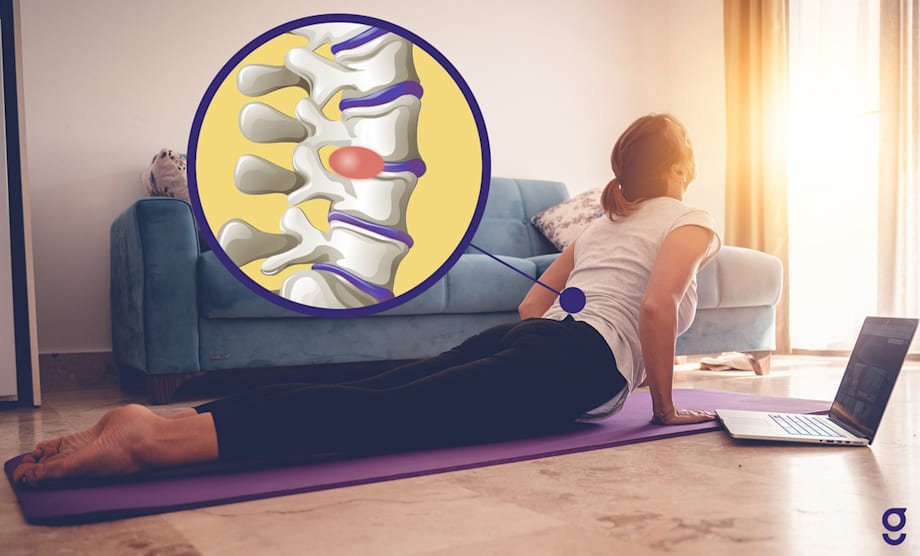A slipped disc, also known as a herniated or prolapsed disc, is a prevalent spinal condition that can cause significant discomfort and mobility issues.
It occurs when the soft, gel-like center of a spinal disc (nucleus pulposus) protrudes through a tear in the tougher outer layer (annulus fibrosus), potentially compressing nearby nerves.
Symptoms
- Pain and numbness: Typically on one side of the body, affecting the back, buttocks, legs, or arms.
- Tingling or burning sensations: In the affected area.
- Muscle weakness: Which may cause you to stumble or impair your ability to lift or hold items.
- Pain that worsens with movement: Activities like sitting, standing, or walking can exacerbate the discomfort.
In severe cases, a slipped disc can lead to loss of bladder or bowel control, necessitating immediate medical attention.
Causes of a Slipped Disc
- Age-related degeneration: As we age, spinal discs lose water content, making them less flexible and more prone to tearing or rupturing with even minor strain or twist.
- Improper lifting techniques: Lifting heavy objects using your back muscles instead of your legs can lead to disc herniation.
- Sedentary lifestyle: Lack of regular exercise can weaken the muscles that support the spine, increasing the risk of disc problems.
- Obesity: Excess body weight increases pressure on the spinal discs, especially in the lower back, making them more prone to degeneration and injury.
- Smoking: It reduces oxygen supply to the disc, causing it to degenerate more quickly.
Physiotherapy Treatment
Physiotherapy plays a crucial role in the non-surgical management of a slipped disc (herniated disc), aiming to alleviate pain, restore mobility, and prevent recurrence.
A personalized physiotherapy program typically encompasses several key components:
1. Pain Relief and Inflammation Reduction
In the initial stages, the focus is on minimizing pain and inflammation. Techniques such as hot or cold pack and gentle manual therapy may be employed. These methods help reduce muscle spasms and improve blood circulation to the affected area and helps in decreasing pain and inflammation.
2. Postural Education
Educating patients on proper posture is vital. Maintaining correct alignment during daily activities reduces undue stress on the spine. Therapists guide patients on ergonomics, emphasizing the importance of neutral spine positions during sitting, standing, and lifting.
3. Flexibility and Stretching Exercises
Gentle stretching exercises enhance flexibility and alleviate pressure on the herniated disc.
4. Strengthening Exercises
Strengthening of core and back muscles are very important and crucial part as these muscles supports the spine.
5. Aerobic Conditioning
Low-impact aerobic exercises, such as walking or swimming, improve cardiovascular health without placing excessive strain on the spine. Regular aerobic activity aids in weight management, which can alleviate pressure on spinal discs.
6. Activity Modification and Ergonomics
Therapists advise on modifying daily activities to prevent aggravation of symptoms. This includes guidance on safe lifting techniques, workspace ergonomics, and incorporating regular breaks during prolonged sitting or standing.
7. Education and Self-Management
Empowering patients with knowledge about their condition fosters adherence to therapy and encourages proactive self-management. Understanding the importance of maintaining an active lifestyle and recognizing early signs of exacerbation are integral to long-term recovery.
8.Manual Therapy Techniques
Nerve Gliding Exercises: These exercises aim to improve the mobility of nerves affected by the disc bulge, reducing symptoms like tingling or numbness.
Joint Mobilizations: Applying controlled movements to spinal joints can enhance mobility and reduce discomfort.
Soft Tissue Manipulation: Techniques like myofascial release relax the affected fascia and relaxes the muscle .
Prevention Strategies
- Regular exercise: Engage in activities that strengthen the core muscles, such as walking, swimming, or yoga, to support the spine.
- Maintain proper posture: Ensure that your sitting and standing positions do not strain your spine.
- Use correct lifting techniques: Always lift heavy objects by bending your knees and keeping your back straight.
- Healthy weight management: Keeping your weight within a healthy range reduces stress on the spine.
- Avoid prolonged sitting: Take regular breaks to stand, stretch, and move around, especially if your job involves long periods of sitting.








